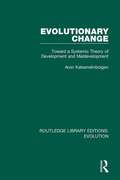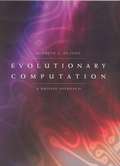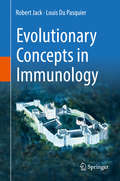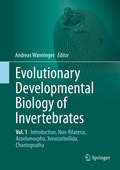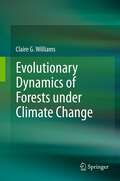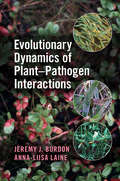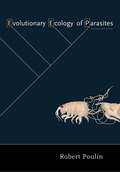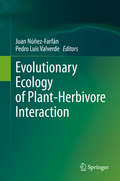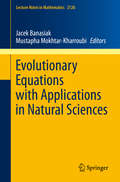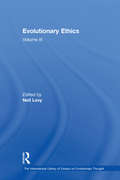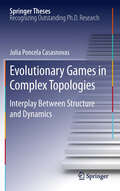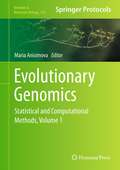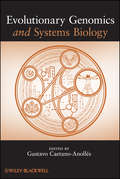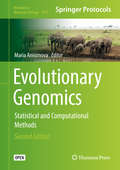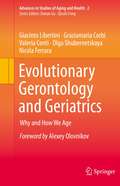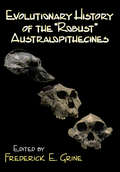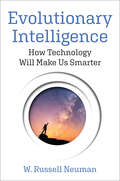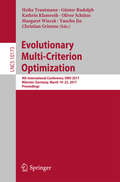- Table View
- List View
Evolutionary Change: Toward a Systemic Theory of Development and Maldevelopment (Routledge Library Editions: Evolution #5)
by Aron KatsenelinboigenOriginally published in 1997 Evolutionary Change addresses the somatic mechanism of change. Although astounding advances in molecular biology have opened up new engineering possibilities to shape our future in terms of "improving" the human species as well as eradicating all kinds of pathological characteristics of biological development, these possibilities pose potentially serious dangers. They arise primarily from the local nature of changes that are introduced and the impact of the environment on the overall development of the biological system. The book explores the biological mechanisms of change in their entirety – as they fit into the general dynamics of biological systems – and demonstrates the pitfalls of tackling change from a narrow perspective, using cancer as an example of certain pathological manifestations of these mechanisms of change.
Evolutionary Computation: A Unified Approach
by Kenneth A. de JongChoice Outstanding Academic Title, 2006. Evolutionary computation, the use of evolutionary systems as computational processes for solving complex problems, is a tool used by computer scientists and engineers who want to harness the power of evolution to build useful new artifacts, by biologists interested in developing and testing better models of natural evolutionary systems, and by artificial life scientists for designing and implementing new artificial evolutionary worlds. In this clear and comprehensive introduction to the field, Kenneth De Jong presents an integrated view of the state of the art in evolutionary computation. Although other books have described such particular areas of the field as genetic algorithms, genetic programming, evolution strategies, and evolutionary programming, Evolutionary Computation is noteworthy for considering these systems as specific instances of a more general class of evolutionary algorithms. This useful overview of a fragmented field is suitable for classroom use or as a reference for computer scientists and engineers.
Evolutionary Concepts in Immunology
by Robert Jack Louis Du PasquierImmunology is a nodal subject that links many areas of biology. It permeates the biosciences, and also plays crucial roles in diagnosis and therapy in areas of clinical medicine ranging from the control of infectious and autoimmune diseases to tumour therapy. Monoclonal antibodies and small molecule modulators of immunity are major factors in the pharmaceutical industry and now constitute a multi billion dollar business. Students in these diverse areas are frequently daunted by the complexity of immunology and the astonishing array of unusual mechanisms that go to make it up.Starting from Dobzhansky’s famous slogan, “Nothing in biology makes sense except in the light of evolution”, this book will serve to illuminate how evolutionary forces shaped immunity and thus provide an explanation for how many of its counter intuitive oddities arose. By doing so it will provide a conceptual framework on which students may organise the rapidly growing flood of immunological knowledge.
Evolutionary Developmental Biology of Invertebrates 3
by Andreas WanningerThis multi-author, six-volume work summarizes our current knowledge on the developmental biology of all major invertebrate animal phyla. The main aspects of cleavage, embryogenesis, organogenesis and gene expression are discussed in an evolutionary framework. Each chapter presents an in-depth yet concise overview of both classical and recent literature, supplemented by numerous color illustrations and micrographs of a given animal group. The largely taxon-based chapters are supplemented by essays on topical aspects relevant to modern-day EvoDevo research such as regeneration, embryos in the fossil record, homology in the age of genomics and the role of EvoDevo in the context of reconstructing evolutionary and phylogenetic scenarios. A list of open questions at the end of each chapter may serve as a source of inspiration for the next generation of EvoDevo scientists. Evolutionary Developmental Biology of Invertebrates is a must-have for any scientist, teacher or student interested in developmental and evolutionary biology as well as in general invertebrate zoology. This is the first of three volumes dedicated to animals that molt in the course of their lifecycle, the Ecdysozoa. It covers all non-hexapods and non-crustaceans, i. e. , the Cycloneuralia, Tardigrada, Onychophora, Chelicerata and Myriapoda. While the Nematoda and all other phyla are treated in their own chapters, the remaining cycloneuralians are presented jointly due to the dearth of available developmental data on its individual subclades.
Evolutionary Dynamics
by Martin A. NowakAt a time of unprecedented expansion in the life sciences, evolution is the one theory that transcends all of biology. Any observation of a living system must ultimately be interpreted in the context of its evolution. Evolutionary change is the consequence of mutation and natural selection, which are two concepts that can be described by mathematical equations. Evolutionary Dynamics is concerned with these equations of life. In this book, Martin A. Nowak draws on the languages of biology and mathematics to outline the mathematical principles according to which life evolves. His work introduces readers to the powerful yet simple laws that govern the evolution of living systems, no matter how complicated they might seem. Evolution has become a mathematical theory, Nowak suggests, and any idea of an evolutionary process or mechanism should be studied in the context of the mathematical equations of evolutionary dynamics. His book presents a range of analytical tools that can be used to this end: fitness landscapes, mutation matrices, genomic sequence space, random drift, quasispecies, replicators, the Prisonerâe(tm)s Dilemma, games in finite and infinite populations, evolutionary graph theory, games on grids, evolutionary kaleidoscopes, fractals, and spatial chaos. Nowak then shows how evolutionary dynamics applies to critical real-world problems, including the progression of viral diseases such as AIDS, the virulence of infectious agents, the unpredictable mutations that lead to cancer, the evolution of altruism, and even the evolution of human language. His book makes a clear and compelling case for understanding every living systemâe"and everything that arises as a consequence of living systemsâe"in terms of evolutionary dynamics.
Evolutionary Dynamics of Forests under Climate Change
by Claire G. WilliamsFocusing on the example of the Lost Pines forest of Texas, this book contextualises the present-day conservation of the Lost Pines within its wealth of historical and geological records. This in turn presents a realistic example for examining evolutionary dynamics models and how they can guide management of temperate pine forests under the uncertainty of future climate change. Synthesising knowledge from many scholarly disciplines, and presenting the latest knowledge on how temperate forests respond to climate change, the book provides insight into how resource professionals actually solve complex multi-layered problems. A useful aid for forest management professionals and for advanced students and professionals in ecology, the book is a valuable resource for researchers and professionals, which can also be used as a classroom exercise for spatial imaging, testing virtual simulations and developing field-based research questions.
Evolutionary Dynamics of Malignancy: The Genetic and Environmental Causes of Cancer
by Robert C. JacksonAdvances in cancer genomics are transforming our understanding of cancer, and have profound implications for its prevention, diagnosis, and treatment. Evolutionary dynamics suggests that as few as two mutations can cause transformation of normal cells into cancer stem cells. A process of Darwinian selection, involving a further three or more mutations, taking place over a period of years, can then result in progression to a life-threatening tumour. In many cases the immune response can recognise and eliminate the mutant cells, but most advanced tumours have mutations that activate immune checkpoints and enable the tumour to hide from the immune system. For the most hard-to-treat tumours, future progress will require molecular diagnostics to detect cancer-causing mutations in healthy subjects, and new drugs or vaccines that prevent the progression process. Chapters of this book deal with the signalling pathways that control cell division, and changes in these pathways in cancer cells. Three cell cycle checkpoints that are often mutated in cancer are analysed in detail. A discussion of chronic myeloid leukaemia illustrates the role of reactive oxygen species in driving progression from a chronic to an acute condition. A single drug that suppresses reactive oxygen can prevent disease progression and turn an otherwise deadly disease into a condition that can be managed to enable many years of normal life. Another chapter discusses chronic myelomonocytic leukaemia, a disease that involves both genetic and epigenetic change. Tumour progression is discussed as a multi-stage process in which cancer stem cells evolve into genetically unstable, invasive, metastatic, drug-resistant growths. Each of these stages can act as targets for drugs or immunomodulators, but the future of cancer treatment lies in understanding tumour dynamics, and arresting malignancy at the earliest possible stage. Evolutionary dynamics is a primarily mathematical technique, but the target readership will be tumour biologists, clinicians, and drug developers. Computational detail is provided in an online supplement, but the main text emphasises the implications of the dynamics for an understanding of tumour biology and does not require mathematical expertise.
Evolutionary Dynamics of Plant-Pathogen Interactions
by Jeremy J. Burdon Anna-Liisa LaineThis volume sits at the cross-roads of a number of areas of scientific interest that, in the past, have largely kept themselves separate - agriculture, forestry, population genetics, ecology, conservation biology, genomics and the protection of plant genetic resources. Yet these areas also have a lot of common interests and increasingly these independent lines of inquiry are tending to coalesce into a more comprehensive view of the complexity of plant-pathogen associations and their ecological and evolutionary dynamics. This interdisciplinary source provides a comprehensive overview of this changing situation by identifying the role of pathogens in shaping plant populations, species and communities, tackling the issue of the increasing importance of invasive and newly emerging diseases and giving broader recognition to the fundamental importance of the influence of space and time (as manifest in the metapopulation concept) in driving epidemiological and co-evolutionary trajectories.
Evolutionary Ecology and Archaeology: Applications to Problems in Human Evolution and Prehistory
by Jack M Broughton Michael D CannonThe field of evolutionary ecology, which applies Darwinian natural selection theory to the study of adaptive design in behavior, morphology, and life history, has produced substantial advances in understanding human evolution and prehistory. Editors Jack Broughton and Michael Cannon have compiled archaeological and paleoanthro- pological studies that provide a foundation for sustained development of the study of the human past. Each of the twenty-four contributions represents a key benchmark in the field. Chapters are grouped by substantive topic and/or time period. Each of the following sections includes an introduction by the editors: • Early Hominid Evolution and Behavior • Pleistocene Foragers and Colonists • Post-Glacial Adaptations • Food Production Strategies • Cooperation and Competition in Complex Societies This volume’s broad range of research will foster sustained development of evolutionary ecology, and like Darwin’s work nearly 150 years ago will open wide fields of understanding of human prehistory.
Evolutionary Ecology of Amphibians
by Gregorio Moreno-Rueda Mar ComasAmphibians are the oldest tetrapod group and show an astonishing diversity in lifestyles, many of them being unique. However, globally, they are on a decline. Hence, their study is fundamental to understanding the evolution of diversity and conserving them. This book, authored by experts from around the world, summarizes the current knowledge on the evolutionary ecology of amphibians. The book treats biological concepts related to the evolution, ecology, physiology, immunology, behaviour, and morphology of amphibians in their different states. This book constitutes an actualized work indispensable for evolutionary ecologists and herpetologists.
Evolutionary Ecology of Parasites: Second Edition
by Robert PoulinParasites have evolved independently in numerous animal lineages, and they now make up a considerable proportion of the biodiversity of life. Not only do they impact humans and other animals in fundamental ways, but in recent years they have become a powerful model system for the study of ecology and evolution, with practical applications in disease prevention. Here, in a thoroughly revised and updated edition of his influential earlier work, Robert Poulin provides an evolutionary ecologist's view of the biology of parasites. He sets forth a comprehensive synthesis of parasite evolutionary ecology, integrating information across scales from the features of individual parasites to the dynamics of parasite populations and the structuring of parasite communities. Evolutionary Ecology of Parasites presents an evolutionary framework for the study of parasite biology, combining theory with empirical examples for a broader understanding of why parasites are as they are and do what they do. An up-to-date synthesis of the field, the book is an ideal teaching tool for advanced courses on the subject. Pointing toward promising directions and setting a research agenda, it will also be an invaluable reference for researchers who seek to extend our knowledge of parasite ecology and evolution.
Evolutionary Ecology of Plant-Herbivore Interaction
by Juan Núñez-Farfán Pedro Luis ValverdePlant-herbivore interactions are a central topic in evolutionary ecology. Historically, their study has been a cornerstone for coevolutionary theory. Starting from classic ecological studies at the phenotypic level, it has since expanded to molecular and genomic approaches. After a historical perspective, the book’s subsequent chapters cover a wide range of topics: from populations to ecosystems; plant- and herbivore-focused studies; in natural and in man-modified ecosystems; and both micro- and macro-evolutionary levels. All chapters include valuable background information and empirical evidence. Given its scope, the book will be of interest to both students and researchers, and will hopefully stimulate further research in this exciting field of evolutionary biology.
Evolutionary Equations with Applications in Natural Sciences
by Jacek Banasiak Mustapha Mokhtar-KharroubiWith the unifying theme of abstract evolutionary equations, both linear and nonlinear, in a complex environment, the book presents a multidisciplinary blend of topics, spanning the fields of theoretical and applied functional analysis, partial differential equations, probability theory and numerical analysis applied to various models coming from theoretical physics, biology, engineering and complexity theory. Truly unique features of the book are: the first simultaneous presentation of two complementary approaches to fragmentation and coagulation problems, by weak compactness methods and by using semigroup techniques, comprehensive exposition of probabilistic methods of analysis of long term dynamics of dynamical systems, semigroup analysis of biological problems and cutting edge pattern formation theory. The book will appeal to postgraduate students and researchers specializing in applications of mathematics to problems arising in natural sciences and engineering.
Evolutionary Ethics: Volume III (The International Library of Essays on Evolutionary Thought)
by Neil LevyMight human morality be a product of evolution? An increasing number of philosophers and scientists believe that moral judgment and behaviour emerged because it enhanced the fitness of our distant ancestors. This volume collects some recent explorations of the evidence for this claim, as well as papers examining its implications. Is an evolved morality a genuine morality? Does an evolutionary origin deflate the pretensions of morality, or strip it of its force in guiding behaviour? Is an evolutionary approach compatible with realism about morality? All sides of these debates are represented in this volume.
Evolutionary Ethnobiology
by Ulysses Paulino Albuquerque Patrícia Muniz De Medeiros Alejandro CasasEthnobiology is a fascinating science. To understand this vocation it needs to be studied under an evolutionary point of view that is very strong and significant, although this aspect is often poorly approached in the literature. This is the first book to compile and discuss information about evolutionary ethnobiology in English.
Evolutionary Games in Complex Topologies
by Julia Poncela CasasnovasThere are many examples of cooperation in Nature: cells cooperate to form tissues, organs cooperate to form living organisms, and individuals cooperate to raise their offspring or to hunt. However, why cooperation emerges and survives in hostile environments, when defecting would be a much more profitable short-term strategy, is a question that still remains open. During the past few years, several explanations have been proposed, including kin and group selection, punishment and reputation mechanisms, or network reciprocity. This last one will be the center of the present study. The thesis explores the interface between the underlying structure of a given population and the outcome of the cooperative dynamics taking place on top of it, (namely, the Prisoner's Dilemma Game). The first part of this work analyzes the case of a static system, where the pattern of connections is fixed, so it does not evolve over time. The second part develops two models for growing topologies, where the growth and the dynamics are entangled.
Evolutionary Genomics
by Maria AnisimovaTogether with early theoretical work in population genetics, the debate on sources of genetic makeup initiated by proponents of the neutral theory made a solid contribution to the spectacular growth in statistical methodologies for molecular evolution. Evolutionary Genomics: Statistical and Computational Methods is intended to bring together the more recent developments in the statistical methodology and the challenges that followed as a result of rapidly improving sequencing technologies. Presented by top scientists from a variety of disciplines, the collection includes a wide spectrum of articles encompassing theoretical works and hands-on tutorials, as well as many reviews with key biological insight. Volume 1 includes a helpful introductory section of bioinformatician primers followed by detailed chapters detailing genomic data assembly, alignment, and homology inference as well as insights into genome evolution from statistical analyses. Written in the highly successful Methods in Molecular BiologyTM series format, this work provides the kind of advice on methodology and implementation that is crucial for getting ahead in genomic data analyses. Comprehensive and cutting-edge, Evolutionary Genomics: Statistical and Computational Methods is a treasure chest of state-of the-art methods to study genomic and omics data, certain to inspire both young and experienced readers to join the interdisciplinary field of evolutionary genomics.
Evolutionary Genomics
by Maria AnisimovaTogether with early theoretical work in population genetics, the debate on sources of genetic makeup initiated by proponents of the neutral theory made a solid contribution to the spectacular growth in statistical methodologies for molecular evolution. Evolutionary Genomics: Statistical and Computational Methods is intended to bring together the more recent developments in the statistical methodology and the challenges that followed as a result of rapidly improving sequencing technologies. Presented by top scientists from a variety of disciplines, the collection includes a wide spectrum of articles encompassing theoretical works and hands-on tutorials, as well as many reviews with key biological insight. Volume 2 begins with phylogenomics and continues with in-depth coverage of natural selection, recombination, and genomic innovation. The remaining chapters treat topics of more recent interest, including population genomics, -omics studies, and computational issues related to the handling of large-scale genomic data. Written in the highly successful Methods in Molecular BiologyTM series format, this work provides the kind of advice on methodology and implementation that is crucial for getting ahead in genomic data analyses. Comprehensive and cutting-edge, Evolutionary Genomics: Statistical and Computational Methods is a treasure chest of state-of the-art methods to study genomic and omics data, certain to inspire both young and experienced readers to join the interdisciplinary field of evolutionary genomics.
Evolutionary Genomics and Systems Biology
by Gustavo Caetano-AnollésA comprehensive, authoritative look at an emergent area in post-genomic science, Evolutionary genomics is an up-and-coming, complex field that attempts to explain the biocomplexity of the living world. Evolutionary Genomics and Systems Biology is the first full-length book to blend established and emerging concepts in bioinformatics, evolution, genomics, and structural biology, with the integrative views of network and systems biology.Three key aspects of evolutionary genomics and systems biology are covered in clear detail: the study of genomic history, i.e., understanding organismal evolution at the genomic level; the study of macromolecular complements, which encompasses the evolution of the protein and RNA machinery that propels life; and the evolutionary and dynamic study of wiring diagrams--macromolecular components in interaction--in the context of genomic complements. The book also features:A solid, comprehensive treatment of phylogenomics, the evolution of genomes, and the evolution of biological networks, within the framework of systems biologyA special section on RNA biology--translation, evolution of structure, and micro RNA and regulation of gene expressionChapters on the mapping of genotypes to phenotypes, the role of information in biology, protein architecture and biological function, chromosomal rearrangements, and biological networks and diseaseContributions by leading authorities on each topicEvolutionary Genomics and Systems Biology is an ideal book for students and professionals in genomics, bioinformatics, evolution, structural biology, complexity, origins of life, systematic biology, and organismal diversity, as well as those individuals interested in aspects of biological sciences as they interface with chemistry, physics, and computer science and engineering.
Evolutionary Genomics: Statistical and Computational Methods (Methods in Molecular Biology #1910)
by Maria AnisimovaThis open access book addresses the challenge of analyzing and understanding the evolutionary dynamics of complex biological systems at the genomic level, and elaborates on some promising strategies that would bring us closer to uncovering of the vital relationships between genotype and phenotype. After a few educational primers, the book continues with sections on sequence homology and alignment, phylogenetic methods to study genome evolution, methodologies for evaluating selective pressures on genomic sequences as well as genomic evolution in light of protein domain architecture and transposable elements, population genomics and other omics, and discussions of current bottlenecks in handling and analyzing genomic data. Written for the highly successful Methods in Molecular Biology series, chapters include the kind of detail and expert implementation advice that lead to the best results. Authoritative and comprehensive, Evolutionary Genomics: Statistical and Computational Methods, Second Edition aims to serve both novices in biology with strong statistics and computational skills, and molecular biologists with a good grasp of standard mathematical concepts, in moving this important field of study forward.
Evolutionary Gerontology and Geriatrics: Why and How We Age (Advances in Studies of Aging and Health #2)
by Giacinto Libertini Graziamaria Corbi Valeria Conti Olga Shubernetskaya Nicola FerraraThis book provides concrete scientific basis that we can conceive the possibility of modifying or even completely canceling aging process, despite the fact that aging is commonly regarded as the result of the overall effects of many uncontrollable degenerative phenomena. The authors illustrate in detail the mechanisms by which cells and the whole organism age. Actions by which it is possible, or will be possible within a limited time, to operate for modifying aging are also debated.The discussion is conducted within the frame and the concepts of evolutionary medicine, which is also indispensable for distinguishing between the manifestations of aging and: (i) diseases that worsen with age, and (ii) acceleration of normal aging rates, caused by unhealthy lifestyle habits and other avoidable factors. The book also discusses the impact of aging on overall mortality and the strange situation that, according to official statistics, aging does not exist as cause of death.This book is a turning point between a gerontology and geriatrics conceived as the study and vain treatment of an incurable condition and one in which these disciplines examine the how and why of a physiological phenomenon that can be modified up to a possible total control. This means transforming the medical prevention and treatment of physiological aging from the greatest failure to the greatest success of medicine.
Evolutionary History
by Edmund RussellWe tend to see history and evolution springing from separate roots, one grounded in the human world and the other in the natural world. Human beings have, however, become probably the most powerful species shaping evolution today, and human-caused evolution in other species has probably been the most important force shaping human history. This book introduces readers to evolutionary history, a new field that unites history and biology to create a fuller understanding of the past than either can produce on its own. Evolutionary history can stimulate surprising new hypotheses for any field of history and evolutionary biology. How many art historians would have guessed that sculpture encouraged the evolution of tuskless elephants? How many biologists would have predicted that human poverty would accelerate animal evolution? How many military historians would have suspected that plant evolution would convert a counter-insurgency strategy into a rebel subsidy? With examples from around the globe, this book will help readers see the broadest patterns of history and the details of their own life in a new light.
Evolutionary History of the Robust Australopithecines
by Frederick E. GrineIn paleoanthropology the group of hominids known as the "robust" australopithecines has emerged as one of the most interesting. Through them we have the opportunity to examine the origin, natural history, and ultimate extinction of not just a single species, but of an entire branch in the hominid fossil record. It is generally agreed that the human lineage can be traced back to this group of comparatively small-brained, large-toothed creatures. This volume focuses on the evolutionary history of these early hominids with state-of-the-art contributions by leading international authorities in the field. Although a case can be made for a "robust" lineage, the functional and taxonomic implications of the morphological features are subject to vigorous disagreement. An area of lively debate is the possible causal relationship between the presence of early Homo and the origin, evolution, and virtual extinction of "robust" australopithecines.This volume summarizes what has been learned about the evolutionary history of the "robust" australopithecines in the 50 years since Robert Broom first encountered the visage of a new kind of ape-man from Kromdraai. New discoveries from Kromdraai to Lomekwi have served to keep us aware that the paleontological record for hominid evolution is hardly exhausted. Because of such finds no single volume can hope to stand as a summary on the "robust" australopithecines for very long, but this classic volume comes close to achieving this goal. The book sheds new light upon some old questions and also acts to provide new questions. The answers to those questions bring us closer to a fuller understanding and appreciation of the origins, evolution, and ultimate demise of the "robust" australopithecines. Since the "robust" australopithecines most likely stand as our closest relatives, a better understanding of their origin, history, and demise serves to provide heightened appreciation of the course of human evolution itself. This definitive volume addresses the questions and problems surrounding this important lineage.
Evolutionary Intelligence: How Technology Will Make Us Smarter
by W. Russell NeumanA surprising vision of how human intelligence will coevolve with digital technology and revolutionize how we think and behave.It is natural for us to fear artificial intelligence. But does Siri really want to kill us? Perhaps we are falling into the trap of projecting human traits onto the machines we might build. In Evolutionary Intelligence, Neuman offers a surprisingly positive vision in which computational intelligence compensates for the well-recognized limits of human judgment, improves decision making, and actually increases our agency. In artful, accessible, and adventurous prose, Neuman takes the reader on an exciting, fast-paced ride, all the while making a convincing case about a revolution in computationally augmented human intelligence.Neuman argues that, just as the wheel made us mobile and machines made us stronger, the migration of artificial intelligence from room-sized computers to laptops to our watches, smart glasses, and even smart contact lenses will transform day-to-day human decision making. If intelligence is the capacity to match means with ends, then augmented intelligence can offer the ability to adapt to changing environments as we face the ultimate challenge of long-term survival.Tapping into a global interest in technology&’s potential impacts on society, economics, and culture, Evolutionary Intelligence demonstrates that our future depends on our ability to computationally compensate for the limitations of a human cognitive system that has only recently graduated from hunting and gathering.
Evolutionary Multi-Criterion Optimization
by Oliver Schütze Heike Trautmann Günter Rudolph Kathrin Klamroth Margaret Wiecek Yaochu Jin Christian GrimmeThis book constitutes the refereed proceedings of the 9th International Conference on Evolutionary Multi-Criterion Optimization, EMO 2017 held in M#65533;nster, Germany in March 2017. The 33 revised full papers presented together with 13 poster presentations were carefully reviewed and selected from 72 submissions. The EMO 2017 aims to discuss all aspects of EMO development and deployment, including theoretical foundations; constraint handling techniques; preference handling techniques; handling of continuous, combinatorial or mixed-integer problems; local search techniques; hybrid approaches; stopping criteria; parallel EMO models; performance evaluation; test functions and benchmark problems; algorithm selection approaches; many-objective optimization; large scale optimization; real-world applications; EMO algorithm implementations.
